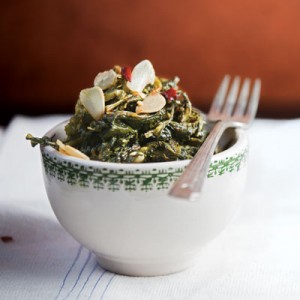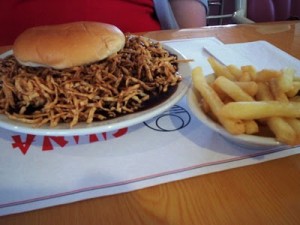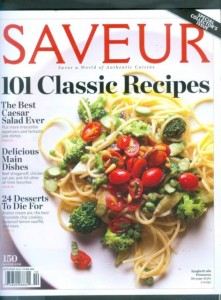August 14th, 2014 § § permalink
SJ introduced the assembled Freeman/Riva clans to Alabama White Sauce Chicken sandwiches last night. A wonder of a dish, just right for happy, informal family feasting. It was accompanied by lots of first of season hot buttered corn on the cob. As HG’s late Mom would say when she wanted to describe the ultimate in deliciousness: “Nu, nu, don’t ask!!” The chicken and corn were preceded by some “Kyoto” style, pickled mackerel sashimi. As previously reported, when Exquisite Maiko first arrived on Prince Edward Island, she picked up numerous fresh mackerel right from the fishing boats at Naufrage harbor. Some were eaten that first night with scallion and ginger, others were air-dried and salted for grilling and a portion were marinated and slightly pickled. They were equally delicious as first-night sashimi with the mackerel flavor intensified by the marinade and the texture gaining a firmer mouth-feel. But, the SJ chicken was the star; Here’s how SJ made the wondrous Alabama Chicken:
Okay, SJ here. This post, by the way, marks the 1000th HUNGRY GERALD post so it is rightfully a collaborative posting between HG and myself (I humbly “edit” HUNGRY GERALD and provide the illustrations to HG’s wonderful writing). Sooo….I first heard of Alabama White Sauce Chicken sandwiches in Saveur Magazine (complete with recipe). It sounded so delicious but oddly none of my friends from Alabama have ever been able to confirm that this dish is actually a part of Alabama’s culinary heritage. Whatever the case, it is a delicious sandwich and this is how I go about making it: spatchcock a chicken (or two) and cut into quarters. Mix a tablespoon each of salt, cumin, coriander, black pepper, garlic powder, celery seeds and a teaspoon of cayenne. Take half this mix and rub into the chickens — when done wrap in plastic and let sit in fridge for a couple of hours. Meanwhile, prepare the white sauce! Take 2 cups Hellman’s Mayo and mix the remainder of the spice mix into it. Then add a half cup of the STRONGEST white horseradish you can find and a quarter cup of apple cider vinegar. Add 2 tablespoons sugar. Mix it all up well. Divide the sauce in two dishes (one for basting the chicken and one for serving with the chicken) After about two hours take chicken out and let it come to room temperature. If you have a smoker, get it ready or if you have a bbq and can get some nice hickory or apple wood chips in there, do that! If you only have an oven, then…you know what, use that as it will still be great. Cook your chicken low and slow at about 225 degrees basting it every 30 minutes with your white sauce. After about 2 hours it should be ready. Shred the chicken discarding the bones (feel free to munch on the skin) and serve on a hamburger bun with dill pickle chips, cole slaw and a hefty dollop of the white sauce! Enjoy!

June 3rd, 2014 § § permalink
Big culinary news is Nashville Hot Chicken. Both SAVEUR and BON APPETIT did articles on it this month. A specialty of some down-home restaurants in the city, the blazingly spicy dish has branched out from Nashville and is now available in a number of places across the USA with franchise plans in the offing. HG doesn’t approve and doesn’t understand the fuss. Basically, this is a deep fried chicken dish with a few salient differences. The chicken is brined in buttermilk laced with Tabasco, rolled in flour and deep fried. Then comes the crazy part. Brown sugar, chile powder, garlic powder and–six to ten tablespoons of cayenne. (That’s a helluva lot of cayenne) are whisked into a cup of cooking oil and brushed over the pieces of fried yardbird. HG figures if you want to set fire to your mouth why go through all these steps. Just a mix a bottle of Tabasco with spoonfuls of cayenne and have at it. HG is a big fan of spicy food but draws the line at masochism. The French, of course, are severe classicists. Hate spicy food. That’s why Mexican, Indian, Thai, etc. food in Paris is so insipid. If a Parisian gets a whiff of cayenne, he signals his disapproval by making fanning motions at his mouth. HG will pass on these foul Nashville fowl and save the HG appetite for SJ’s newest passion: Alabama Chicken. Recipe, please, SJ.

January 17th, 2014 § § permalink
The Maghreb is the culturally distinct region of North Africa (Algeria, Tunisia and Morocco) fronting on the Mediterranean Sea. HG loves the food from this part of the world and enjoys its splendors whenever possible. There’s a good article on Maghreb food in Paris by Jay Cheshes (SAVEUR–Nov. 12, 2012). Cheshes mentions two great street foods: Casse-croute (Tunisian tuna and vegetable sandwich) and Mahjouba (Algerian crepes rolled around grilled vegetables). Why do working class Parisians have all the luck? Why can’t we Americans have these treats instead of hamburgers? Cheaper and healthier. In a recent post, HG mentioned the excellent (at a very modest price) chicken and preserved lemon tagine with couscous HG enjoyed at Restaurant Jour et Nuit on Paris’s gritty Boulevard de la Chapelle. Close to that place is Dar el Houma (mentioned by Cheshy) which specializes in chicken tagines atop Maghreb noodles. Sounds pleasing. Also in the area is Les Trois Freres which in addition to couscous, does a mean steak et frites. Makes HG want to hustle back to Paris. Sadly, Maghreb food has not really proliferated in the United States. Surprising, since dumbed-down Mexican, Italian and Chinese food is available everywhere. Couscous has gained a foothold in American kitchens, but has not really infiltrated US restaurants. In all of HG’s many years in New York, HG remembers only one good couscous joint. This was a place in the West Greenwich Village where a jolly Israeli guy dished out maximum couscous dinners at minimal prices. Long closed. Sad.

July 20th, 2013 § § permalink
Cookbooks make for pleasant reading and often better viewing (some cookbook photography is so lustfully shot that it is basically pornographic). They often have good cooking ideas and can serve as an active spur to the imagination. But, very few contain recipes that, when followed step-by-step, turn out right. Mark Bittman, the ubiquitous Bittman, is the great advocate of simplicity and a best-selling cookbook author. In HG’s opinion, Bittman’s recipes disappoint. They should be read as creative outlines to constructing a dish rather than precise instructions. The recipes in Saveur Magazine sure read good but make for unfortunate eating (SJ disagrees). HG relies on three cookbook authors: Mimi Sheraton (the former New York Times restaurant reviewer); the late Michael Field and Marcella Hazan, the woman who has had a powerful and positive impact on cooking Italian food in the home kitchen. Mimi Sheraton’s cookbook, From My Mother’s Kitchen, is an HG favorite. There is a strong emphasis on Jewish cooking (but not kosher—there are good recipes for clams, lobster and a ham-and-bean soup). The recipes are can’t miss and they emphasize simple things like matzo brei, blintzes, fish salads, pan broiled steaks and hamburgers, etc. Michael Field’s books feature precise recipes. Do exactly as he says and you have a winner dish. Always. Marcella Hazan is invaluable. However, it is necessary to adjust the quantities. She likes, in the Italian fashion, a lot of pasta and a little bit of sauce. A lot of Americans (including HG/BSK) like the reverse.

April 6th, 2013 § § permalink
There seems to be a prevalent belief among American professional chefs and home cooks that vegetables should be cooked al dente — just a shade softer than raw. The technique (fostered by the late Julia Child): Blanch vegetables in boiling water. Remove. Stop the cooking by rinsing in ice water. Saute briefly. Serve. HG disagrees. Like our neighbors in the Southern states, HG likes soft vegetables cooked into creamy goodness. (There is an exception. BSK cooks a very al dente broccoli di rabe with lots of garlic and red chili. It’s good. Would be better if she left it in the pan for another ten minutes). HG likes the well done haricot verts in Paris (and the glazed carrots served in bistros with some beef stews). Italians, who can be immoderate in politics, choose a middle way in cuisine. They don’t like things too hot or too cold. And they like–as is proper–vegetables cooked beyond the al dente stage. HG has very few cooked vegetable allies. But, an outstanding advocate of slow and long vegetable cooking is Lesley Porcelli (a woman of Italian lineage, of course). You can find an excellent article by her in the October 2011 issue of Saveur Magazine. Take a peek at her recipes: Slow-coked broccoli di rabe with crushed red chiles and garlic; olive oil braised mixed vegetables; Indian- style carrots with mustard seeds; braised celery and tomatoes; Lebanese-style green beans with chick peas in olive oil. All savory and full of lush flavors.

February 25th, 2013 § § permalink
It seems that the very odd treat — the chow mein sandwich — is alive and well. As HG has previously posted, the Chow Mein sandwich is a guilty pleasure, a low-end treat relished by HG and only available at Nathan’s Famous hot dog emporium on Coney Island and its branch (long closed) in the mid-Manhattan movie and theater district. A very messy sandwich. Care and numerous napkins ae required. A year ago, this sandwich appeared at Lee’s Chinese in Rhode Island. And now, HG has just read, with pleasure, that the chow mein sandwich has been thriving at Mee Sum Restaurant and Cocktail Lounge in Fall River, Mass. Jane and Michael Stern, those intrepid discoverers of funky food on America’s highways (and creators of the seminal Road Food Good Food books and website), reported on the cuisine of Fall River in this month’s (March 2013) issue of Saveur Magazine. They describe the excellence of the noodles on the Mee Sum sandwich: “Thin and elegant, fried until wicked crisp, the noodles are an ideal foil for brown gravy laced with celery and onion. The sandwich is a fascinating textural swirl: soft and crunchy, wet and brittle.” The Sterns, noting the treat is “mischievously delicious,” observe the chow mein sandwich is little known except as an “oddity” at Nathan’s. It all sounds good but the mention of “brown gravy” is enticing. Nathan’s sandwich binds the celery and onions with a traditional, light beige, corn starch thickened, gravy. Does this difference of gravy darkness represent a genuine, regional split?

September 28th, 2012 § § permalink
Do not miss the current issue of SAVEUR. The magazine celebrates its 150th issue by compiling 101 classic recipes for appetizers, main courses and deserts. The recipes are super and very international. The world is covered. HG does not miss GOURMET. Always found the magazine a bit precious and elitist. BON APPETIT (under its new editorship) is much better. For good recipes and food ideas, HG likes the blog of David Lebovitz, a Paris-based writer. If food and restaurant writing interests you, discover Waverley Root, a wonderful writer and dining companion of the incomparable A.J. Liebling. Also, see if you can source some of the dining articles by that mannered, ridiculous dandy, Lucius Beebe. Great retro fun.

February 22nd, 2012 § § permalink
HG was delighted to see the wedding pictures of Saveur editor-in-chief James Oseland and his partner Carlos Daniel Dos Santos in the current issue of the magazine. Typical of Oseland’s sophisticated (but unpretentious) style is the fact that the wedding feast was held at the Excellent Pork Chop House, a seemingly simple but very good Taiwanese restaurant in New York’s Chinatown. Oseland, in his comparatively short time leading the magazine, has made Saveur the best food magazine in the world. Gourmet was getting good with Ruth Reichl at the helm but Oseland has taken Saveur to another level.
HG was a charter subscriber to Saveur when Dorothy Kalins, an outstanding journalist/editor, launched the publication with the scintillating Bobbi Schlesinger of Freeman Public Relations — HG’s successor firm — being the magazine’s effective publicist. HG had been concerned about Saveur’s future as Metropolitan Home, Gourmet, House and Garden and other excellent magazines have not been able to weather these difficult economic times. Saveur is, in fact, thriving. And, that’s good news for anyone who loves to eat and cook. James and Carlos, HG wishes you many, many happy years.








